How to Install a Playstation Cable Onto a Multi-Console Cthulhu
by Toodles in Circuits > Electronics
33113 Views, 23 Favorites, 0 Comments
How to Install a Playstation Cable Onto a Multi-Console Cthulhu
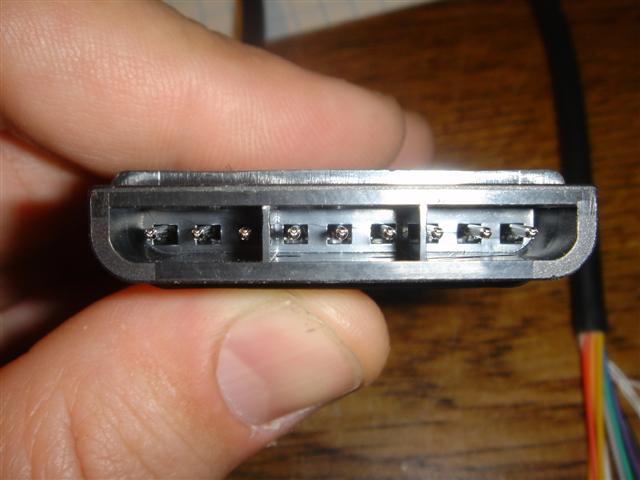.JPG)
This Instructable will guide you through installing a Playstation or Playstation 2 style controller cable onto a multi-console 'MC' Cthulhu.
All of the information about the Cthulhu project is available online in the Shoryuken.com forums:
http://forums.shoryuken.com/showthread.php?t=162026
Please be quite aware that this Instructable applies only to the MC Cthulhu; if your Cthulhu was purchased advertised only for PS3/PC use, then you cannot add a Playstation cable and expect it to work. Upgrade chips are available if you would like to turn your PS3 Only Cthulhu into an MC Cthulhu. If you are unsure which one you have, plug your arcade stick into your computer with the Start and Select buttons held down. if you see a new device called 'Cthulhu Bootloader' get installed, you have an MC Cthulhu. If you only see your arcade stick show up as normal, then it is not an MC Cthulhu.
All of the information about the Cthulhu project is available online in the Shoryuken.com forums:
http://forums.shoryuken.com/showthread.php?t=162026
Please be quite aware that this Instructable applies only to the MC Cthulhu; if your Cthulhu was purchased advertised only for PS3/PC use, then you cannot add a Playstation cable and expect it to work. Upgrade chips are available if you would like to turn your PS3 Only Cthulhu into an MC Cthulhu. If you are unsure which one you have, plug your arcade stick into your computer with the Start and Select buttons held down. if you see a new device called 'Cthulhu Bootloader' get installed, you have an MC Cthulhu. If you only see your arcade stick show up as normal, then it is not an MC Cthulhu.
Step 1: Get to Know Your Cable
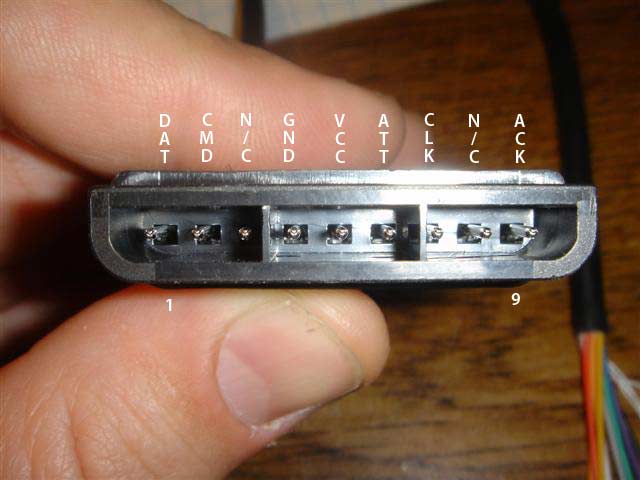
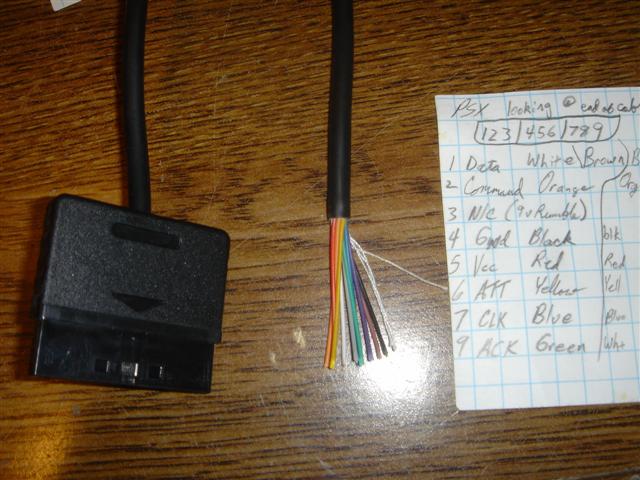.JPG)
Before heating up the iron and jumping in without a plan, it is very important you take a moment to get to know what to expect. Let's start by getting to know your Playstation cable.
You can use any kind of cable that has a male Playstation end, like the one pictured. You can scavenge these from dead controllers easily, or purchase a Playstation extension cord like I've done here. If you have an extension cord, cut the female end off as close to the end as you can, so you are left only with the male end and as much cord as possible.
Remove about 1 1/4" inches (3-4 cm) of insulation off of the end, exposing the insulated wires from the cable. If there is any sort of uninsulated wire or metallic shielding, go ahead and trim it off next to the end of the main cable insulation. If you have any heat shrink tubing of the right thickness to barely go over the main cable insulation, go ahead and slide it on now so you won't forget it later. The heat shrink tubing is optional, but definitely makes for a professional looking installation.
Strip about 1-2 mm of insulation off of the end of each of the smaller wires, exposing the copper. Get your multimeter ready to check for continuity, and a small piece of paper and pencil to jot down what you find.
The first picture below shows the proper name for each of the wires in the Playstation cable along with their pin number. 'N/C' means not connected; we don't need to connect them to the Cthulhu.
Our job now is to identify which of the colored wires in the Playstation cable go to which of the pins on the end. I will give a listing of which color goes to which pin on the extension cables I have used; feel free to use this as an initial guide for your testing, but you MUST check each pin of the cable. The colors on Playstation cables seem to have a very loose standard; for example I've seen DATA lines be white in one cable, and brown on the next. Use this to try and get your pinout done quickly, but it is NOT a substitute for testing yourself. (The Cthulhu Column entry should be ignored for now. Get the pinout done before ever heating up your soldering iron.)
Color Purpose Pin # Cthulhu Column
Brown - DATA - 1 - C
Orange - CMD - 2 - B
Black - GND - 4 - G
Red - VCC - 5 - V
Yellow - ATT - 6 - D
Blue - CLK - 7 - A
Green - ACK - 9 - F
(Color pinout for the newer shiny blue cables I sell)
Brown - DATA - 1 - C
Orange - CMD - 2 - B
Black - GND - 4 - G
Purple - VCC - 5 - V
Yellow - ATT - 6 - D
Blue - CLK - 7 - A
Green - ACK - 9 - F
Once you've pinned out the cable, locate all of the rest of the wires that don't match the pins, and trim them short around the end of the insulation. They aren't needed.
You can use any kind of cable that has a male Playstation end, like the one pictured. You can scavenge these from dead controllers easily, or purchase a Playstation extension cord like I've done here. If you have an extension cord, cut the female end off as close to the end as you can, so you are left only with the male end and as much cord as possible.
Remove about 1 1/4" inches (3-4 cm) of insulation off of the end, exposing the insulated wires from the cable. If there is any sort of uninsulated wire or metallic shielding, go ahead and trim it off next to the end of the main cable insulation. If you have any heat shrink tubing of the right thickness to barely go over the main cable insulation, go ahead and slide it on now so you won't forget it later. The heat shrink tubing is optional, but definitely makes for a professional looking installation.
Strip about 1-2 mm of insulation off of the end of each of the smaller wires, exposing the copper. Get your multimeter ready to check for continuity, and a small piece of paper and pencil to jot down what you find.
The first picture below shows the proper name for each of the wires in the Playstation cable along with their pin number. 'N/C' means not connected; we don't need to connect them to the Cthulhu.
Our job now is to identify which of the colored wires in the Playstation cable go to which of the pins on the end. I will give a listing of which color goes to which pin on the extension cables I have used; feel free to use this as an initial guide for your testing, but you MUST check each pin of the cable. The colors on Playstation cables seem to have a very loose standard; for example I've seen DATA lines be white in one cable, and brown on the next. Use this to try and get your pinout done quickly, but it is NOT a substitute for testing yourself. (The Cthulhu Column entry should be ignored for now. Get the pinout done before ever heating up your soldering iron.)
Color Purpose Pin # Cthulhu Column
Brown - DATA - 1 - C
Orange - CMD - 2 - B
Black - GND - 4 - G
Red - VCC - 5 - V
Yellow - ATT - 6 - D
Blue - CLK - 7 - A
Green - ACK - 9 - F
(Color pinout for the newer shiny blue cables I sell)
Brown - DATA - 1 - C
Orange - CMD - 2 - B
Black - GND - 4 - G
Purple - VCC - 5 - V
Yellow - ATT - 6 - D
Blue - CLK - 7 - A
Green - ACK - 9 - F
Once you've pinned out the cable, locate all of the rest of the wires that don't match the pins, and trim them short around the end of the insulation. They aren't needed.
Prepare the Cable

This is a quick step, but very recommended to help make things go smoother. Tin your wires.
The easiest way I've found to accomplish this is to twist the copper wires together so you have no stragglers, then apply a little flux onto the exposed copper at the end of each wire. Melt a little solder on the end of your iron, and touch it to your wire. With the flux, the wire will drink up the solder, leaving a much easier to use and solder single piece to solder to the board, instead of multiple thin copper threads. The insulation on the wire will melt and retract a little bit; that will actually help make things easier when we solder.
The easiest way I've found to accomplish this is to twist the copper wires together so you have no stragglers, then apply a little flux onto the exposed copper at the end of each wire. Melt a little solder on the end of your iron, and touch it to your wire. With the flux, the wire will drink up the solder, leaving a much easier to use and solder single piece to solder to the board, instead of multiple thin copper threads. The insulation on the wire will melt and retract a little bit; that will actually help make things easier when we solder.
Identify Locations
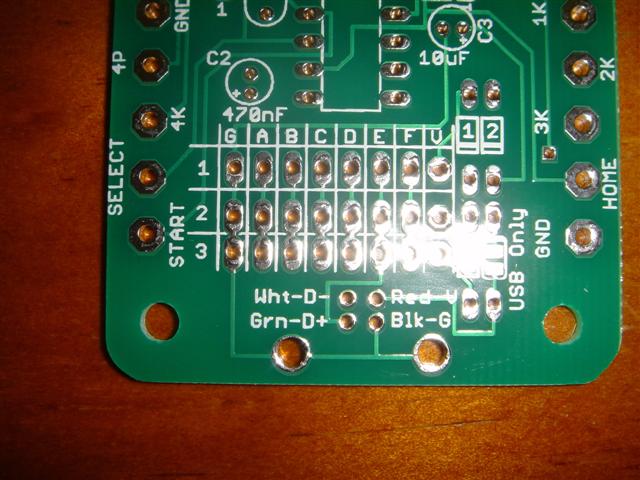.JPG)
The wires on the Playstation cord need to be soldered to specific spots in order to work well. Take a moment to identify where you will be soldering the cable to shortly.
Below is a picture of an unassembled Cthulhu board showing the grid of holes where the console cables get installed. For most console cables, it doesn't matter which of the three rows you use; for Playstation, however, it DOES matter. We will be soldering the Playstation cable ONLY to row 1.
Now that we know which row of holes to use, we just need to figure out which wires go where. Grab the sheet of paper you wrote the pinout on. Each wire has a purpose, and a specific place it must go. Remember, the colors below are ONLY and example. Use the pin # or Purpose you wrote down earlier to determine which column to use.
Color Purpose Pin # Cthulhu Column
Brown - DATA - 1 - C
Orange - CMD - 2 - B
Black - GND - 4 - G
Red - VCC - 5 - V
Yellow - ATT - 6 - D
Blue - CLK - 7 - A
Green - ACK - 9 - F
There you have it. You should have seven wires tinned and ready to solder, and you now know which wire does what, and which row (1) and column each one goes into. Let's get to it.
Below is a picture of an unassembled Cthulhu board showing the grid of holes where the console cables get installed. For most console cables, it doesn't matter which of the three rows you use; for Playstation, however, it DOES matter. We will be soldering the Playstation cable ONLY to row 1.
Now that we know which row of holes to use, we just need to figure out which wires go where. Grab the sheet of paper you wrote the pinout on. Each wire has a purpose, and a specific place it must go. Remember, the colors below are ONLY and example. Use the pin # or Purpose you wrote down earlier to determine which column to use.
Color Purpose Pin # Cthulhu Column
Brown - DATA - 1 - C
Orange - CMD - 2 - B
Black - GND - 4 - G
Red - VCC - 5 - V
Yellow - ATT - 6 - D
Blue - CLK - 7 - A
Green - ACK - 9 - F
There you have it. You should have seven wires tinned and ready to solder, and you now know which wire does what, and which row (1) and column each one goes into. Let's get to it.
Begin Soldering
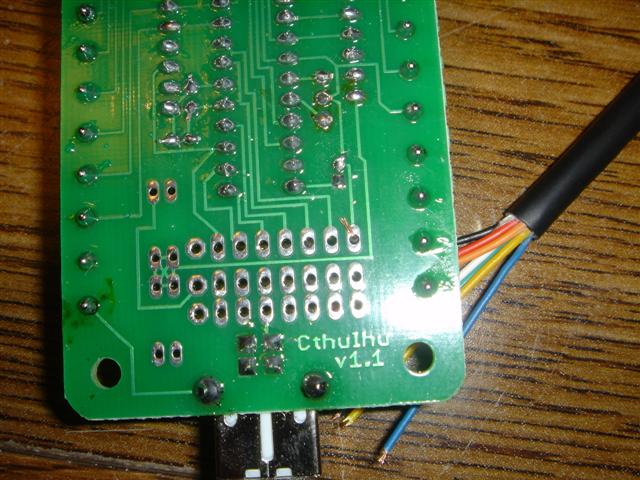.JPG)
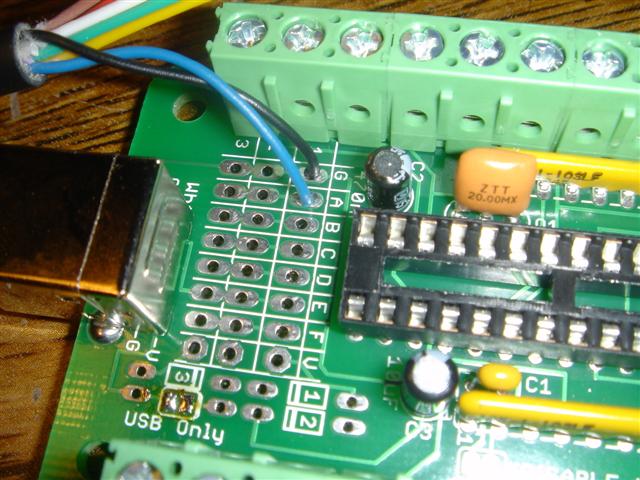.JPG)
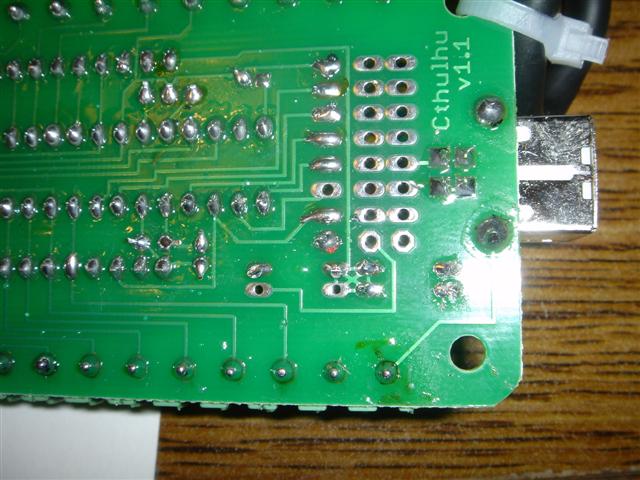.JPG)
We now know what wire goes where, so heat up the iron.
I recommend starting and one end and working your way individually to the other. I start with the G column, would through A-F, and finally V, left-to right.
Take the GND wire, place it through the row 1 column G hole so the insulation stops at the board. Take a finger, bend the wire over from underneath and hold it in place while you flip the board over. Solder the wire in place, and trim off any excess wire.
Repeat down the same row for each wire in turn.
I recommend starting and one end and working your way individually to the other. I start with the G column, would through A-F, and finally V, left-to right.
Take the GND wire, place it through the row 1 column G hole so the insulation stops at the board. Take a finger, bend the wire over from underneath and hold it in place while you flip the board over. Solder the wire in place, and trim off any excess wire.
Repeat down the same row for each wire in turn.
Final Clean-Up and Test
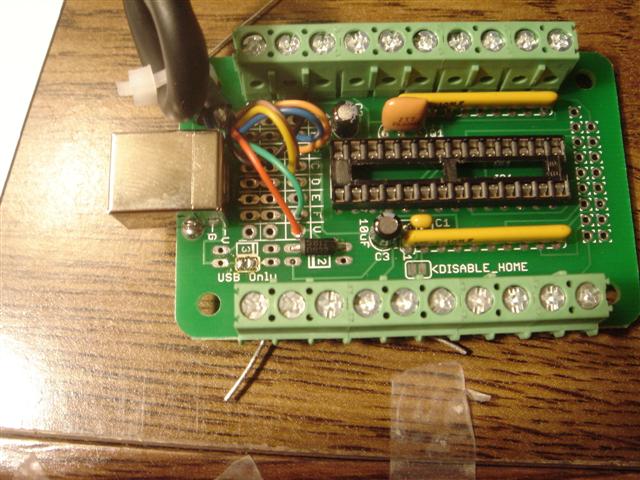.JPG)
The most important thing you can do is trust your instincts. If anything looks or feels wrong, fix it.
Next, test anyways to prevent any catastrophic problems. The worst thing you can do is accidentally cause a short. Use your multimeter to check for continuity between the VCC screw terminal (top right-most screw terminal in the picture below) and a GND terminal (like the lower left-most terminal) If there is a low resistance present, you MUST fix it before even thinking about testing the board out. It would be very dangerous to plug it into anything without locating the short and fixing it. The ground and power lines in the columns you just soldered to are very far apart, so this sort of mistake will be rare, but it is better to test for it now.
If you used heat shrink tubing, slide it down over the wires as far as you can, and use a heat source such as a heat gun, or even a lighter, to shrink it down over the wires.
A note on final installation: The cable is secured to the board with only the seven very thin wires. In the event of even slight force, these wires will not hold. It is very important when installing in your arcade stick that you device some method of strain relief, so any tugging on the cable will be stop and not result in pressure on these small wires. The usual method I prefer is to make a small look in the cable, secure the loop with a zip tie, and making sure the loop is as close to the exit of the case as possible. If the cable gets tugged at all, the loop is far too big to exit the case, preventing the thin wires from being pulled.
Give it a test, and enoy your stick with a good Playstation game!
Next, test anyways to prevent any catastrophic problems. The worst thing you can do is accidentally cause a short. Use your multimeter to check for continuity between the VCC screw terminal (top right-most screw terminal in the picture below) and a GND terminal (like the lower left-most terminal) If there is a low resistance present, you MUST fix it before even thinking about testing the board out. It would be very dangerous to plug it into anything without locating the short and fixing it. The ground and power lines in the columns you just soldered to are very far apart, so this sort of mistake will be rare, but it is better to test for it now.
If you used heat shrink tubing, slide it down over the wires as far as you can, and use a heat source such as a heat gun, or even a lighter, to shrink it down over the wires.
A note on final installation: The cable is secured to the board with only the seven very thin wires. In the event of even slight force, these wires will not hold. It is very important when installing in your arcade stick that you device some method of strain relief, so any tugging on the cable will be stop and not result in pressure on these small wires. The usual method I prefer is to make a small look in the cable, secure the loop with a zip tie, and making sure the loop is as close to the exit of the case as possible. If the cable gets tugged at all, the loop is far too big to exit the case, preventing the thin wires from being pulled.
Give it a test, and enoy your stick with a good Playstation game!